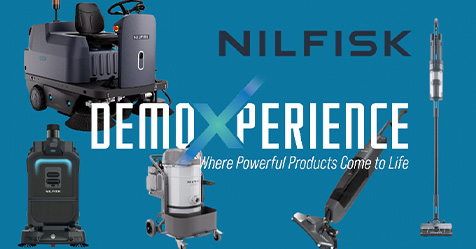I was introduced to hard surface floor care in 1975 by my good friend and mentor George Price, founder of Cleanology.
His instructions were that we wanted to avoid stripping as long as possible.
The program consisted of using a red can and a red pad to do regular buffing, a blue can with a blue pad to take off the top layer of floor finish and then reapply a coat of finish.
When the floor was damaged by some activity, such as an individual urinating on it, we would take a black pad with a black can — which was referred to as dry stripping — and remove a little more than the top layer of finish.
This system worked extremely well but had huge drawbacks: The time it took to maintain the floors was significant, the product was expensive and we could not use the black can for stripping large areas of flooring.
I eventually was involved with stripping the floors and immediately understood why George instructed me to properly maintain the floors to minimize the stripping process.
Over the course of the next 33 years, I never forgot that learning opportunity and have experienced countless times the challenges of what I refer to as slurry stripping.
In my entire career, the most serious injuries I”ve incurred have been from slurry stripping, the most expensive single activity within a facility.
The procedure is very messy, the cleanup is a big job and the process leaves an opportunity for other cleaning issues such as stripping solution migrating to unintended areas.
The list goes on and on as to why any reduction of slurry stripping is advantageous.
Within the JanSan industry, we have accepted that the only method of removing floor finish is the slurry stripping method in some variation.
In the summer of 2009, I had the opportunity to purchase an autoscrubber, which had a flat pad on it and was touted to be capable of dry stripping hard surfaces.
I purchased the scrubber, and it does a wonderful job of scrubbing the floors, but the stripping part — not so good.
However, the concept intrigued me, so I took a machine that we traditionally used for gym floors and used it on a hallway to see how it removed the floor finish.
The result was astounding and the only way I could describe it was that we pulverized the floor finish; it literally became a white powder.
I called my local supplier and told him he needed to come see me as soon as possible.
I told him he was going to see one of the most revolutionary techniques I have ever seen regarding floor finish removal.
My supplier, Kevin Brady, owner of Square Scrub Inc., was equally as excited.
We used this machine in various hallways and numerous rooms to observe the results.
I knew that we had stumbled into an entirely new concept for removing floor finish.
Perfecting The Process
We had some serious issues with the machine we were using — dust being the first.
After using this machine on a fairly large amount of flooring, I knew that this method was to become an industry standard.
Brady, too, understood the potential and, over the course of a few weeks, had developed a prototype for us to test.
From this single event, an entirely new approach toward the removal of floor finish was created.
We have used this technique in millions of square feet, and I am still amazed at how effective this approach is.
The benefits are numerous; below are some of the more significant ones:
- Elimination of slips and falls due to slippery floors
- Need for multiple pieces of equipment eliminated
- Difficult and time-consuming end-of-job cleanup reduced
- Cleaning of baseboards no longer required
- Traditional slurry stripping problems abolished
- Water usage reduced
- Amount of electricity required significantly reduced
- Reduction in labor hours
- Amount of necessary floor finish reduced.
According to studies, we are reducing an estimated .88 gallons of water per square foot.
Although we do not have an exact number, wet stripping a 900-square-foot classroom requires a buffer and wet/dry vacuum for upwards of 40 minutes each for a total of 80 minutes of electricity use.
With the dry stripping method, you can complete a room with a single machine in 10 minutes, saving 30 minutes per room of electricity use.
Aside from the energy savings are the reduction of water, the reduction of electricity, the reduction of airborne contaminants and the elimination of pouring the slurried finish and stripper solution down the drain and into the environment.
With the dry method, floor finish removal can be done by one person versus a normal crew of three people — there is no cleanup crew, as there is no mess.
We estimate that we are reducing the labor by 50 percent to 80 percent with the dry stripping method of pulverizing the floor finish.
We have discovered that the dry method does an extraordinarily good job of preparing the floor and, for various reasons, the first coat has a much higher gloss than with the slurry method.
Surprisingly, and with astonishing results, we reduce a minimum of one coat of finish through the dry method.
For the top coating process, the dry method is so superior to any other method that we believe it will ultimately become the standard method.
Imagine that you can send one person to scrub and recoat floors by themselves, reducing the required time by 75 percent and eliminating the risks associated with floor stripping and finishing.
Dry stripping with oscillating technology is the most revolutionary process to ever be introduced to floor care and will positively transform your hard surface floor care program.
The green advantage is enormous, and this method is the ultimate environmentally-friendly floor care approach.
Plus, the recoated floor will be shinier than any other method you have ever used.

